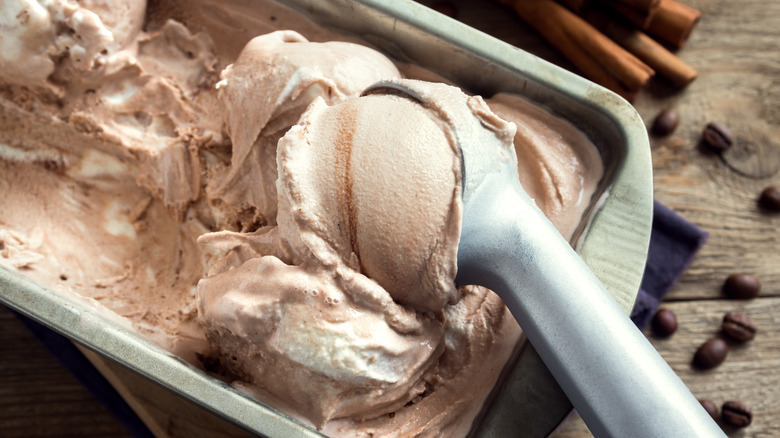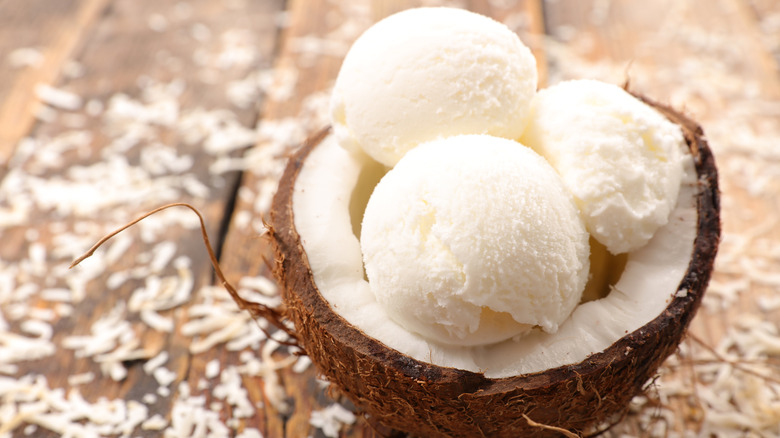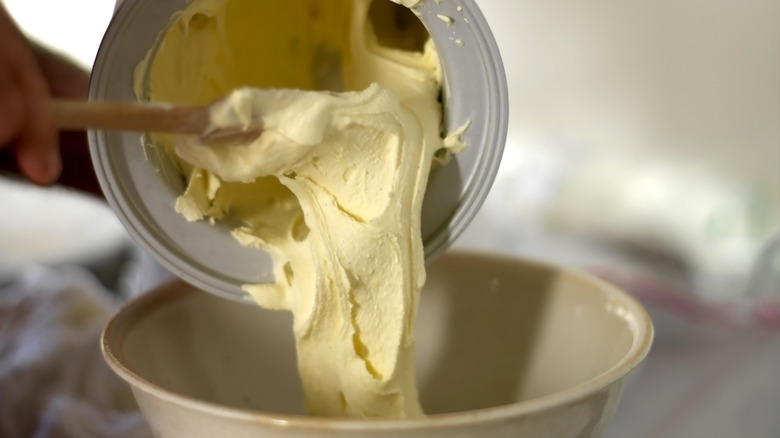The Perfect Egg Substitute You Need For Creamy Ice Cream
Egg yolks are a key ingredient in many homemade ice cream recipes. They're packed with fat and protein to support a creamy, rich structure. Lecithin, a lipid found in egg yolks, acts as a natural emulsifier to create a smooth, consistent texture with creamy deliciousness in every scoop. Meticulously cooking egg yolks on your stovetop into a custard base is the golden ticket to a creamy outcome, and it's well worth the effort.
But while you have to crack a few eggs to make an omelet, the same doesn't necessarily ring true when it comes to homemade ice cream. Whether you need to go egg-free for allergy reasons or you just don't have the eggs — or the patience — to make a custard, try a cornstarch and cream cheese base instead. This technique, made popular by award-winning ice cream maker Jeni Britton Bauer (who's known to pair beer with her ice cream), results in a flavorful frozen treat with a luscious consistency that rivals that of French-style custard-based recipes.
Cornstarch, used to make a slurry, takes over the stabilizing role of lecithin by thickening the liquid components of the ice cream. This helps keep the water from separating from the fat, so it won't form dreaded ice crystals — the antithesis of smooth, creamy ice cream. A few tablespoons of cream cheese add back in the protein and fat from the egg yolks for a luscious mouthfeel.
Make creamy ice cream without eggs or dairy
When both eggs and dairy are off the table, creamy homemade ice cream doesn't have to be. There are myriad plant-based ingredients that can work together to create a non-dairy dessert that's as soft and scoopable as its milk-based counterpart. A cornstarch slurry can step in as the stabilizer in nondairy ice cream, joining forces with plant-based protein and fat sources for a velvety end result.
Full-fat coconut milk is a popular ingredient in non-dairy ice cream because it has plenty of protein and fat compared to other types of plant milk. It does, indeed, add a noticeable taste of coconut that pairs deliciously with chocolate and vanilla. If you're not a fan of coconut, try swapping or mixing with another vegan milk, like almond, oat, or cashew milk for a more subtle, versatile flavor. Refined coconut oil supplies fat without adding an overpowering coconut-y taste. Avocados and bananas, too, can bring plant-based fat and decadent creaminess to nondairy ice cream.
How to keep your ice cream creamy
The key is to freeze your ice cream as quickly as possible before large ice crystals and a grainy, freezer-burnt texture can form. Allow your ice cream base to chill in the refrigerator for at least four hours, as a warm mixture may fail to set and might be why your ice cream won't freeze. For an even creamier outcome, though, age your base in the fridge overnight before moving on to churning. A longer chill time gives the proteins and fats plenty of time to bond, potentially contributing to a smoother result.
Make sure the mixing bowl of your ice cream machine is completely frozen before churning. That way, your ice cream will set smoothly and evenly. This can take up to 24 hours. Make sure not to over-churn everything. While it may seem that extra time in the machine would result in a creamier dessert, delaying the final freeze can actually lead to more unwanted ice crystals.
Once your ice cream is set, transfer it to a plastic container, not glass as they take longer to freeze. Cover your ice cream with plastic wrap and an airtight lid to keep out air and moisture that cause freezer burn. The best place to store ice cream is in the back of your freezer at the lowest temperature possible. Eat your homemade dessert within two weeks for optimal deliciousness.



